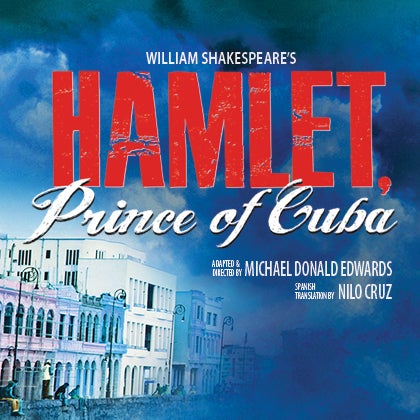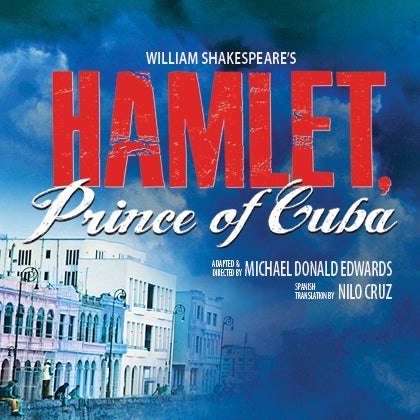Educator Resources: Hamlet, Prince of Cuba
What’s on this page? 
- Introduction- How to use the Curriculum and Production
- Suggested Classroom Viewing and Discussion Questions
- Content Guide
- Take it Further Resources: Translating Shakespeare, Santería, Jose Marti, and The Cuban Revolution
- Hear from the Artists: Engage on Air and Inside Asolo Rep Interviews
- CPALMS Standards
How to Use the Curriculum Digital Production Guide
Whether you’re teaching remotely, working in a school, or homeschooling you will find engaging resources, behind-the-scenes glimpses, and videos that activate and enhance your viewing experience.
The Digital Production Guide was created with the hope that your students can explore the context, culture, and creation of Hamlet, Prince of Cuba on their own. See below to learn more about the curriculum and prepare to join Hamlet in his quest for vengeance.

Is this Production Right For Your Class?
We have created a Content Guide that accompanies the streaming of this production.
This guide includes information that will aid educators in priming their students for viewing more difficult or mature scenes onstage.
Additionally, it has information on the production and curriculum in one easy place. Making it quickly accessible for administrators or parents.

Suggested Classroom Viewing and Discussion Questions
Run Time: Approximately one hour and fifty-nine minutes long.
In the drop-down below, we have suggested stop times or breaks in the action. These are places where you can pause the production in order to check student comprehension or for your convenience when planning viewing lengths according to your bell schedule.
-
Stop Times and Discussion Questions
-
- Stop at 17:54- At the end of “To Be” speech
- What did you see, what hear, what did you feel?
- So far, how do you see Cuba and the Cuban culture in this show?
- How did Hamlet react to the ghost’s revelation? What do you think Hamlet will do next?
- How was the ghost different in this production than when you read the play or watched it otherwise? (Teachers learn more about the ghost and Santerían on the Cultura Page or in the Educator Resources below)
- How was listening in Spanish and reading Shakespearean English for you?
- Stop at 30:11- Right before Polonius and the Players entrance
- What has happened so far?
- Do you think Hamlet is actually insane or is he pretending?
- What jokes or comedic relief did you notice in these scenes?
- Why did Shakespeare and the director include humor in a tragedy?
- Stop at 39:36- At end of the speech
- What is Hamlet's Plan?
- Do you think it will work?
- Content warning at 43:16- imitation of sex/rape (Hamlet sits on top of Ophelia and thrusts. Duration 17 seconds.)
- What is Hamlet's Plan?
- Stop 57:12- At blackout
- How are the women in this play treated by Hamlet?
- Why do you think this is so?
- How are the women in this play treated by Hamlet?
- Hamlet says the play-within-a-play is called "The Mousetrap".
- Why do you think this is the title?
- What changes can you see in Hamlet's madness and his relationships?
- What will happen next?
- Stop at 1:09- At blackout.
- Which characters are you rooting for?
- What proof do we have of Claudius’s guilt?
- What type of relationship do you think Hamlet had with his parents before the action in this play?
- What will the king and queen do next?
- Stop at 1:15- Intermission Blackout
- How do you expect Hamlet to act in the second half of this play?
- What do you think will happen next?
- Stop at 1:24- At Claudius, Laertes, and Gertrude’s exit
- How is Ophelia’s madness different from Hamlet's?
- Both Hamlet and Laertes are sons seeking revenge for their father’s murder. How are they similar, how are they different?
- Stop at 1:31- After Ophelia’s death is announced
- Do you think Claudius’s plot will work? Why? Why not?
- Why do you think Shakespeare chose to kill Ophelia?
- STOP at 1:40- After Ophelia’s grave is closed
- Why does Shakespeare include the comedic gravedigger scene right in the middle of the climax of the play?
- Did Hamlet truly love Ophelia?
- STOP at 1:58-End of Play
- How is Hamlet's friendship with Horatio different from his friendship with Rosencrantz and Guildenstern's?
- Would he have reacted differently if Horatio had betrayed him?
- What is a foil in literary terms? How has Shakespeare set Hamlet and Laertes up to be foils of each other?
- Was Hamlet getting his revenge satisfying for you? Why or why not?
- Fortinbras appears at the end and looks very different from all the other characters. Why do you think that is? Who do you think he represents in the context of Cuban Revolution? (Teddy Roosevelt when he was an American Rough Riders fighting in the Cuban Revolution)
- Why do you think we still tell the story of Hamlet today?
- Stop at 17:54- At the end of “To Be” speech

Take it Further Resources:
In the drop-downs below, we have gathered a few extra resources that you can choose to use to enhance your classroom learning. Hand these resources over to your students and have them do independent research or use the information as a part of a lecture before viewing the production. We have attempted to include a general source, a more academic source, and one in Spanish each time.
Have something you want more information on? Let us know at education@asolo.org
-
RESOURCE: Translating Shakespeare
-
Did you know Hamlet was the first Shakespearean play to be translated into Spanish in the 18th Century?!
Find external articles and information exploring the translation of Shakespeare below. These resources enhance the "Palabras, Palabras, Palabras..." curriculum page.
- The Production of Hamlet, Prince of Cuba was featured in the book Shakespeare Studies, Vol. XLIV in the chapter "From West Side Story to Hamlet, Prince of Cuba: Shakespeare and Latinidad in the United States" by Carla Della Gatta.
- Find excerpts of the chapter and buy the book here
- Request a digital copy of the chapter from a university library.
- A scholarly article on translating Hamlet.
- Strategies and considerations for adding a second language to a production.
- Article exploring the power of reinventing Shakespeare in the Spanish language.
- Traduciendo Shakespeare a el Espanol
- The Production of Hamlet, Prince of Cuba was featured in the book Shakespeare Studies, Vol. XLIV in the chapter "From West Side Story to Hamlet, Prince of Cuba: Shakespeare and Latinidad in the United States" by Carla Della Gatta.
-
RESOURCE: Santería
-
In our production of Hamlet, Prince of Cuba the ghost of King Hamlet appears to his son through the practice of Santería. Learn more about this religion and its impact on Cuban culture through the links and articles below. These resources enhance the "Cultura" curriculum page.
-
RESOURCE: The Cuban Revolution in the 1800's
-
This production is set in Cuba in the 1800's as Cuba fights for its independence. Learn more about Cuban Revolution and this time period through the articles and links below. These resources enhance the "Cultura" curriculum page.
-
RESOURCE: José Martí
-
José Martí was a Cuban writer and national hero who was known for translating and adapting universal stories. His poetry and stories are a huge part of Cuban culture. Not only was José Martí working and writing during the time period that Hamlet, Prince of Cuba is set, but he also worked as a part of the Cuban Revolution. See how the production used Martí as an inspiration on the "Cultura" page.
Resources:
One of Martí's Most Famous Poems:
LOS DOS PRÍNCIPES
El palacio está de luto
Y en el trono llora el rey,
Y la reina está llorando
Donde no la puedan ver:
En pañuelos de holá fino
Lloran la reina y el rey:
Los señores del palacio
Están llorando también.
Los caballos llevan negro
El penacho y el arnés:
Los caballos no han comido,
Porque no quieren comer:
El laurel del patio grande
Quedó sin hoja esta vez:
Todo el mundo fue al entierro
Con coronas de laurel:
—¡El hijo del rey se ha muerto!
¡Se ha muerto el hijo del rey!
En los álamos del monte
Tiene su casa el pastor:
La pastora está diciendo
“¿Por qué tiene luz el sol?”
Las ovejas, cabizbajas,
Viene todas al portón:
¡Una caja larga y honda
está forrando el pastor!
Entra y sale un perro triste:
Canta allá adentro una voz—
“¡Pajarito, yo estoy loca,
Llévame donde él voló!”:
El pastor coge llorando
La pala y el azadón:
Abre en la tierra una fosa:
Echa en la fosa una flor:
—¡Se quedó el pastor sin hijo!
¡Murió el hijo del pastor!THE TWO PRINCES
The palace is in mourning,
The king cries on his throne;
The queen is also crying,
She's crying all alone.
In handkerchiefs of pure lace
They cry in disbelief,
The nobles of the palace,
Beside themselves with grief.
The royal horses, once so bright,
Are now in black-array:
The horses did not eat last night —
Nor wanted food today.
The courtyard's stately laurel tree
Is stripped of all its leaves:
The people of the country
All carry laurel wreaths.
The king's son has died today:
The king's heir has passed away.
Upon the hill, the shepherd
Has built his simple home:
The shepherdess to ask is heard:
"Why does the sun still come?"
With lowered heads, the sheep
Approach the shepherd's door:
A box he's lining, long and deep,
Upon the cottage floor.
A sad dog keeps watch there;
From the hut is heard a moan:
"Little bird, take me where
My precious one has flown."
The weeping shepherd takes the spade,
And sinks it in the bower,
And in the hole that he has made
The shepherd lays his flower.
The shepherd's son has died today,
The shepherd's heir has passed away.

Hear from the Artists:
Engage on Air
As a part of our Engage on Air podcast, Artistic Director Michael Donald Edwards sat down and talked with translator Nilo Cruz and actor Frankie J. Alverez about the production and their time working on it. Excerpts from these conversations and discussion questions can be found on the content pages. However, if you wish to share or listen to the full episodes, you can find them below.
Content Note: These full episodes contain references to, adult relationships, current political views and events, violence, and more. The excerpts on the curriculum site do not include these moments.
Inside Asolo Rep Interviews
Director and adaptor Michael Donald Edwards and his Assistant Director, Jesse Ontiveros talk with Resident Dramaturg, Lauryn Sasso about Shakespeare, language, and the production of Hamlet, Prince of Cuba!
(These videos were filmed in 2012)
Inside Asolo Rep Part 2

Standards
Check below for a detailed list of Florida State Standards that connect with grades 7th-12th. These standards are fullfilled by the combination of watching the production of Asolo Rep’s Hamlet, Prince of Cuba and using the online curriculum.
-
READING/TEXT ANALYSIS STANDARDS
-
-
LAFS. 4-8.RL.1.1 Ask and answer questions to demonstrate understanding of a text, referring explicitly to the text as the basis for the answers.
-
LAFS. 4-8.RL.3.7 Use information gained from the illustrations and words in a print or digital text to demonstrate understanding of its characters, setting, or plot.
-
LAFS. 4-8.RL.1.3 Describe characters in a story (e.g., their traits, motivations, or feelings) and explain how their actions contribute to the sequence of events.
-
LAFS.910.RL.1.3 Analyze how complex characters (e.g., those with multiple or conflicting motivations) develop over the course of a text, interact with other characters, and advance the plot or develop the theme.
-
-
VOCABULARY STANDARDS
-
-
LAFS.4-8.L.3.5 Demonstrate understanding of word relationships and nuances in word meanings.
-
LAFS.910.RI.2.4 Determine the meaning of words and phrases as they are used in a text, including figurative, connotative, and technical meanings; analyze the cumulative impact of specific word choices on meaning and tone (e.g., how the language of a court opinion differs from that of a newspaper).
-
LAFS.1112.RL.2.4 Determine the meaning of words and phrases as they are used in the text, including figurative and connotative meanings; analyze the impact of specific word choices on meaning and tone, including words with multiple meanings or language that is particularly fresh, engaging, or beautiful. (Include Shakespeare as well as other authors.)
-
LAFS.1112.RL.3.7
Analyze multiple interpretations of a story, drama, or poem (e.g., recorded or live production of a play or recorded novel or poetry), evaluating how each version interprets the source text. (Include at least one play by Shakespeare and one play by an American dramatist.)
-
-
THEATRE ARTS STANDARDS
-
-
TH.68.S.2.3 Analyze the relationships of plot, conflict, and theme in a play and transfer the knowledge to a play that contrasts in style, genre, and/or mood.
-
TH.68.H.1.5 Describe one’s own personal responses to a theatrical work and show respect for the responses of others.
-
TH.912.C.1.3 Justify a response to a theatrical experience through oral or written analysis, using correct theatre terminology.
-
TH.912.H.1.1 Analyze how playwrights’ work reflects the cultural and socio-political framework in which it was created.
-
TH.912.H.1.4 Interpret a text through different social, cultural, and historical lenses to consider how perspective and context shape a work and its characters.
-
TH.912.H.1.5 Respect the rights of performers and audience members to perform or view controversial work with sensitivity to school and community standards.
-
TH.912.H.2.1 Research the correlations between theatrical forms and the social, cultural, historical, and political climates from which they emerged, to form an understanding of the influences that have shaped theatre.
-
TH.912.H.2.2 Research and discuss the effects of personal experience, culture, and current events that shape individual response to theatrical works.
-
TH.912.H.2.6 Explore how gender, race, and age are perceived in plays and how they affect the development of theatre.
-
-
WORLD LANGUAGE
-
- WL.K12.IM.1.2 Demonstrate understanding of the main idea and supporting details of presentations on familiar topics.
-
WL.K12.AL.1.2 Follow presentations on familiar and unfamiliar topics in different situations.
-
WL.K12.AM.1.3 Demonstrate understanding of presentations even when idiomatic, technical, or slang expressions are used.
-
WL.K12.AM.1.4 Demonstrate understanding of the underlying meaning of culturally authentic expressions as presented through a variety of media.
-
WL.K12.AH.1.1 Demonstrate understanding of extended speech and short lectures on a variety of topics.
-
WL.K12.SU.1.6 Follow information from recorded authentic complex passages.
Sign-up to Stream Hamlet, Prince of Cuba
Stream world-class Asolo Rep productions that fit into curriculum and are catalysts for classroom conversations. These viewing experiences have been designed to take students from the virtual classroom into the wide-world of theatre and back again!
Bring More Professional Theatre into your Classroom
Stream world-class Asolo Rep productions that fit into curriculum and are catalysts for classroom conversations. These viewing experiences have been designed to take students from the virtual classroom into the wide world of theatre and back again!
Explore Classroom Resources from Asolo Rep
Are you looking for more theatre resources for your classroom? Asolo Rep's Education and Engagement Department is working hard to create and curate activities, methods, and content that educators, administrators, and parents can use in their classroom and digital classroom.
-
Learn More about Asolo Rep Education & Engagement!
-


